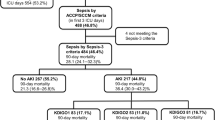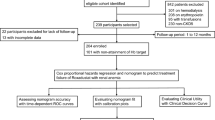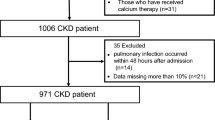Abstract
Background
Infections associated with nephrotic relapses (NR) are often managed according to physician preferences. A validated prediction tool will aid clinical decision-making and help in rationalizing antibiotic prescriptions. Our objective was to develop a biomarker-based prediction model and a regression nomogram for the prediction of the probability of infection in children with NR. We also aimed to perform a decision curve analysis (DCA).
Methods
This cross-sectional study included children (1–18 years) with NR. The outcome of interest was the presence of bacterial infection as diagnosed using standard clinical definitions. Total leucocyte count (TLC), absolute neutrophil count (ANC), quantitative C-reactive protein (qCRP), and procalcitonin (PCT) were the biomarker predictors. Logistic regression was used to identify the best biomarker model, followed by discrimination and calibration testing. Subsequently, a probability nomogram was constructed and DCA was done to determine the clinical utility and net benefits.
Results
We included 150 relapse episodes. A bacterial infection was diagnosed in 35%. Multivariate analysis showed the ANC + qCRP model to be the best predictive model. This model displayed excellent discrimination (AUC: 0.83), and calibration (optimism-adjusted intercept: 0.015, slope: 0.926). A prediction nomogram and web-application was developed. The superiority of the model was also confirmed by DCA in the probability threshold range of 15–60%.
Conclusions
An ANC-based and qCRP-based internally validated nomogram can be used for the prediction of probability of infection in non-critically ill children with NR. Decision curves from this study will aid in the decision-making of empirical antibiotic therapy, incorporating threshold probabilities as a surrogate of physician preference.
Graphical abstract

A higher resolution version of the Graphical abstract is available as Supplementary information




Similar content being viewed by others
Data availability
Data will be made available on request.
Code availability
Not applicable.
References
Ajayan P, Krishnamurthy S, Biswal N, Mandal J (2013) Clinical spectrum and predictive risk factors of major infections in hospitalized children with nephrotic syndrome. Indian Pediatr 50:779–781. https://doi.org/10.1007/s13312-013-0214-x
Alwadhi RK, Mathew JL, Rath B (2004) Clinical profile of children with nephrotic syndrome not on glucorticoid therapy, but presenting with infection. J Paediatr Child Health 40:28–32. https://doi.org/10.1111/j.1440-1754.2004.00285.x
Yap HK, Han EJ, Heng CK, Gong WK (2001) Risk factors for steroid dependency in children with idiopathic nephrotic syndrome. Pediatr Nephrol 16:1049–1052. https://doi.org/10.1007/s004670100024
Gulati S, Kher V, Gupta A, Arora P, Rai PK, Sharma RK (1995) Spectrum of infections in Indian children with nephrotic syndrome. Pediatr Nephrol 9:431–434. https://doi.org/10.1007/BF00866719
Tain YL, Lin G, Cher TW (1999) Microbiological spectrum of septicemia and peritonitis in nephrotic children. Pediatr Nephrol 13:835–837. https://doi.org/10.1007/s004670050710
Lebel A, Kropach N, Ashkenazi-Hoffnung L, Huber-Yaron A, Davidovits M (2020) Infections in children with nephrotic syndrome: twenty years of experience. Clin Pediatr (Phila) 59:692–698. https://doi.org/10.1177/0009922820908583
Mishra OP, Abhinay A, Mishra RN, Prasad R, Pohl M (2013) Can we predict relapses in children with idiopathic steroid-sensitive nephrotic syndrome? J Trop Pediatr 59:343–349. https://doi.org/10.1093/tropej/fmt029
Mathew G, George AS, Deepthi RV, Rose W, Verghese VP, Varghese R, Veeraraghavan B, Agarwal I (2023) Epidemiology and outcomes of pneumococcal sepsis in children with nephrotic syndrome in a developing country. Pediatr Nephrol 38:131–137. https://doi.org/10.1007/s00467-022-05550-0
Dusemund F, Bucher B, Meyer S, Thomann R, Kühn F, Bassetti S, Sprenger M, Baechli E, Sigrist T, Schwietert M, Amin D, Hausfater P, Carre E, Schuetz P, Gaillat J, Regez K, Bossart R, Schild U, Müller B, Albrich WC; ProREAL Study Team (2013) Influence of procalcitonin on decision to start antibiotic treatment in patients with a lower respiratory tract infection: insight from the observational multicentric ProREAL surveillance. Eur J Clin Microbiol Infect Dis 32:51–60. https://doi.org/10.1007/s10096-012-1713-8
Waterfield T, Maney JA, Hanna M, Fairley D, Shields MD (2018) Point-of-care testing for procalcitonin in identifying bacterial infections in young infants: a diagnostic accuracy study. BMC Pediatr 18:387. https://doi.org/10.1186/s12887-018-1349-7
Sakallioglu O, Musabak U, Kalman S (2012) Procalcitonin and minimal-change nephropathy: a pilot study. Singapore Med J 53:353–356
Harbarth S, Holeckova K, Froidevaux C, Pittet D, Ricou B, Grau GE, Vadas L, Pugin J, Network Geneva Sepsis (2001) Diagnostic value of procalcitonin, interleukin-6, and interleukin-8 in critically ill patients admitted with suspected sepsis. Am J Respir Crit Care Med 164:396–402. https://doi.org/10.1164/ajrccm.164.3.2009052
Hugle T, Schuetz P, Mueller B, Laifer G, Tyndall A, Regenass S, Daikeler T (2008) Serum procalcitonin for discrimination between septic and non-septic arthritis. Clin Exp Rheumatol 26:453–456
Rhee C, Mansour MK (2022) Procalcitonin use in lower respiratory tract infections. UpToDate. https://www.uptodate.com. Accessed 06 December 2022
Aabenhus R, Jensen JU, Jørgensen KJ, Hróbjartsson A, Bjerrum L (2014) Biomarkers as point-of-care tests to guide prescription of antibiotics in patients with acute respiratory infections in primary care. Cochrane Database Syst Rev 11:CD010130. https://doi.org/10.1002/14651858.CD010130.pub2
Escadafal C, Incardona S, Fernandez-Carballo BL, Dittrich S (2020) The good and the bad: using C reactive protein to distinguish bacterial from non-bacterial infection among febrile patients in low-resource settings. BMJ Glob Health 5:e002396. https://doi.org/10.1136/bmjgh-2020-002396
Keitel K, Samaka J, Masimba J, Temba H, Said Z, Kagoro F, Mlaganile T, Sangu W, Genton B, D’Acremont V (2019) Safety and efficacy of C-reactive protein-guided antibiotic use to treat acute respiratory infections in Tanzanian children: a planned subgroup analysis of a randomized controlled noninferiority trial evaluating a novel electronic clinical decision algorithm (ePOCT). Clin Infect Dis 69:1926–1934. https://doi.org/10.1093/cid/ciz080
Keitel K, Kagoro F, Samaka J, Masimba J, Said Z, Temba H, Mlaganile T, Sangu W, Rambaud-Althaus C, Gervaix A, Genton B, D’Acremont V (2017) A novel electronic algorithm using host biomarker point-of-care tests for the management of febrile illnesses in Tanzanian children (e-POCT): a randomized, controlled non-inferiority trial. PLoS Med 14:e1002411. https://doi.org/10.1371/journal.pmed.1002411
Vickers AJ, Elkin EB (2006) Decision curve analysis: a novel method for evaluating prediction models. Med Decis Making 26:565–574. https://doi.org/10.1177/0272989X06295361
Moons KG, Altman DG, Reitsma JB, Ioannidis JP, Macaskill P, Steyerberg EW, Vickers AJ, Ransohoff DF, Collins GS (2015) Transparent Reporting of a multivariable prediction model for Individual Prognosis or Diagnosis (TRIPOD): explanation and elaboration. Ann Intern Med 162:W1-73. https://doi.org/10.7326/M14-0698
Hingorani SR, Weiss NS, Watkins SL (2002) Predictors of peritonitis in children with nephrotic syndrome. Pediatr Nephrol 17:678–682. https://doi.org/10.1007/s00467-002-0890-6
Feinstein EI, Chesney RW, Zelikovic I (1988) Peritonitis in childhood renal disease. Am J Nephrol 8:147–165. https://doi.org/10.1159/000167575
Shaikh, N, Hoberma A (2021) Urinary tract infections in infants and children older than one month: clinical features and diagnosis. UpToDate. https://www.uptodate.com. Accessed 6 December 2022
van Smeden M, Moons KG, de Groot JA, Collins GS, Altman DG, Eijkemans MJ, Reitsma JB (2019) Sample size for binary logistic prediction models: beyond events per variable criteria. Stat Methods Med Res 28:2455–2474. https://doi.org/10.1177/0962280218784726
Luque-Fernandez MA, Redondo-Sánchez D, Maringe C (2019) cvauroc: command to compute cross-validated area under the curve for ROC analysis after predictive modeling for binary outcomes. Stata J 19:615–625. https://doi.org/10.1177/1536867X19874237
Fernandez-Felix BM, García-Esquinas E, Muriel A, Royuela A, Zamora J (2021) Bootstrap internal validation command for predictive logistic regression models. Stata J 21:498–509. https://doi.org/10.1177/1536867X211025836
Austin PC, Steyerberg EW (2014) Graphical assessment of internal and external calibration of logistic regression models by using loess smoothers. Stat Med 33:517–535. https://doi.org/10.1002/sim.5941
Nattino G, Finazzi S, Bertolini G (2016) A new test and graphical tool to assess the goodness of fit of logistic regression models. Stat Med 35:709–720. https://doi.org/10.1002/sim.6744
Zlotnik A, Abraira V (2015) A general-purpose nomogram generator for predictive logistic regression models. Stata J 15:537–546. https://doi.org/10.1177/1536867X1501500212
Vickers AJ, Van Calster B, Steyerberg EW (2016) Net benefit approaches to the evaluation of prediction models, molecular markers, and diagnostic tests. BMJ (Clin Res ed) 352:i6. https://doi.org/10.1136/bmj.i6
Alfakeekh K, Azar M, Sowailmi BA, Alsulaiman S, Makdob SA, Omair A, Albanyan E, Bawazeer MS (2019) Immunosuppressive burden and risk factors of infection in primary childhood nephrotic syndrome. J Infect Public Health 12:90–94. https://doi.org/10.1016/j.jiph.2018.09.006
Hassan I, Tiewsoh JBA, Ray P, Dawman L, Rathore V, Suri D, Tiewsoh K (2019) Changing spectrum of infections in childhood nephrotic syndrome. Indian J Pediatr 86:1065. https://doi.org/10.1007/s12098-019-03007-1
De S, Williams GJ, Hayen A, Macaskill P, McCaskill M, Isaacs D, Craig JC (2014) Value of white cell count in predicting serious bacterial infection in febrile children under 5 years of age. Arch Dis Child 99:493–499. https://doi.org/10.1136/archdischild-2013-304754
Cruz AT, Mahajan P, Bonsu BK, Bennett JE, Levine DA, Alpern ER, Nigrovic LE, Atabaki SM, Cohen DM, VanBuren JM, Ramilo O, Kuppermann N (2017) Febrile Infant Working Group of the Pediatric Emergency Care Applied Research Network. Accuracy of complete blood cell counts to identify febrile infants 60 days or younger with invasive bacterial infections. JAMA Pediatr 171:e172927. https://doi.org/10.1001/jamapediatrics.2017.2927
Lacour AG, Zamora SA, Gervaix A (2008) A score identifying serious bacterial infections in children with fever without source. Pediatr Infect Dis J 27:654–656. https://doi.org/10.1097/INF.0b013e318168d2b4
Smedemark SA, Aabenhus R, Llor C, Fournaise A, Olsen O, Jørgensen KJ (2022) Biomarkers as point-of-care tests to guide prescription of antibiotics in people with acute respiratory infections in primary care. Cochrane Database Syst Rev 10:CD010130. https://doi.org/10.1002/14651858.CD010130.pub3
Schuetz P, Suter-Widmer I, Chaudri A, Christ-Crain M, Zimmerli W, Mueller B (2011) Prognostic value of procalcitonin in community-acquired pneumonia. Eur Respir J 37:384–392. https://doi.org/10.1183/09031936.00035610
Yo CH, Hsieh PS, Lee SH, Wu JY, Chang SS, Tasi KC, Lee CC (2012) Comparison of the test characteristics of procalcitonin to C-reactive protein and leukocytosis for the detection of serious bacterial infections in children presenting with fever without source: a systematic review and meta-analysis. Ann Emerg Med 60:591–600. https://doi.org/10.1016/j.annemergmed.2012.05.027
Nijman RG, Moll HA, Smit FJ, Gervaix A, Weerkamp F, Vergouwe Y, de Rijke YB, Oostenbrink R (2014) C-reactive protein, procalcitonin and the lab-score for detecting serious bacterial infections in febrile children at the emergency department: a prospective observational study. Pediatr Infect Dis J 33:e273–e279. https://doi.org/10.1097/INF.0000000000000466
Grimes DA (2008) The nomogram epidemic: resurgence of a medical relic. Ann Intern Med 149:273–275. https://doi.org/10.7326/0003-4819-149-4-200808190-00010
Acknowledgements
The authors wish to thank the study participants and their parents, the resident doctors, nurses, and technicians from the departments of Pediatrics, Biochemistry, and Microbiology.
Author information
Authors and Affiliations
Contributions
ST, VC, YVN, ED, and MA were involved in the study design and data acquisition. ST and VC were involved in data analysis and interpretation. ST, VC, YVN, ED, and MA drafted the manuscript, performed critical revisions, and gave final approval for submission.
Corresponding author
Ethics declarations
Ethics approval
The study was approved by the Institutional ethics committee (LHMC/IEC/2019/102), and conducted in accordance with Good Clinical Practice and the Declaration of Helsinki.
Consent to participate
Written informed consent was obtained from the parents or legal guardians of all children. When possible, the assent from pediatric patients themselves was also obtained.
Consent for publication
Study participants gave a written informed consent for publication of the results of the study before their enrolment in the study.
Competing interests
The authors declare no competing interests.
Additional information
Publisher's note
Springer Nature remains neutral with regard to jurisdictional claims in published maps and institutional affiliations.
Supplementary Information
Below is the link to the electronic supplementary material.
Rights and permissions
Springer Nature or its licensor (e.g. a society or other partner) holds exclusive rights to this article under a publishing agreement with the author(s) or other rightsholder(s); author self-archiving of the accepted manuscript version of this article is solely governed by the terms of such publishing agreement and applicable law.
About this article
Cite this article
Narayana, Y.V., Chhapola, V., Tiwari, S. et al. Diagnosis of bacterial infection in children with relapse of nephrotic syndrome: a personalized decision-analytic nomogram and decision curve analysis. Pediatr Nephrol 38, 2689–2698 (2023). https://doi.org/10.1007/s00467-023-05915-z
Received:
Revised:
Accepted:
Published:
Issue Date:
DOI: https://doi.org/10.1007/s00467-023-05915-z




